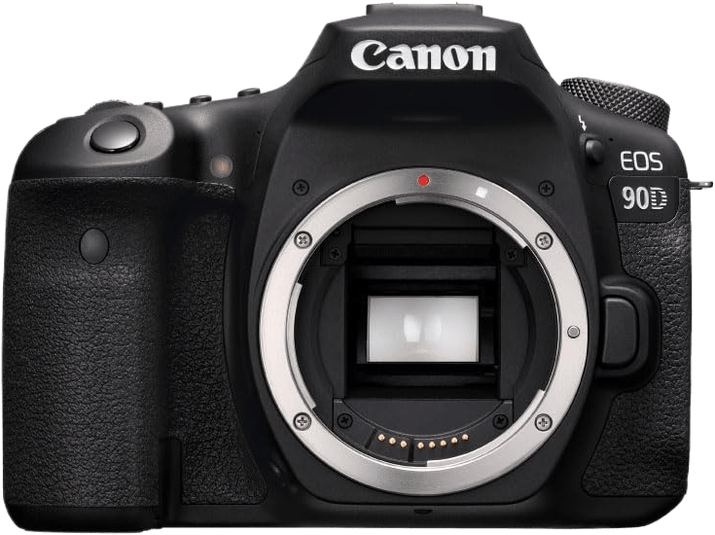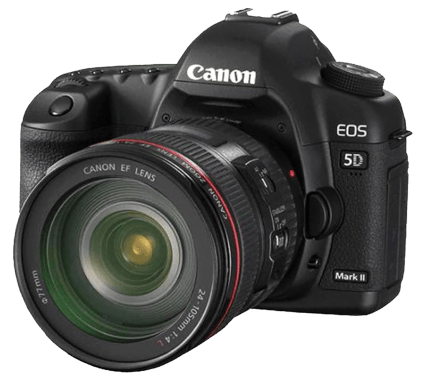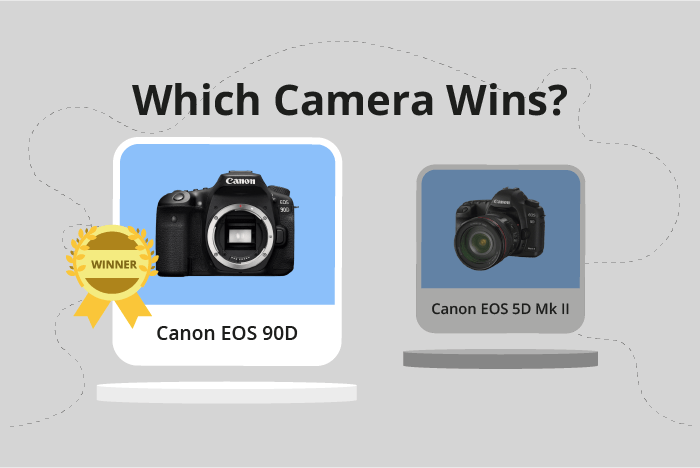Canon EOS 90D vs EOS 5D Mark II Comparison
Canon EOS 90D

Canon EOS 5D Mark II

The Canon EOS 90D outperforms the Canon EOS 5D Mark II with a score of 67/100 compared to 58/100. Both cameras are DSLR models, released in 2019 and 2008 respectively. They share common specifications, such as camera type and dimensions, with the 90D measuring 141 x 105 x 77mm and the 5D Mark II at 152 x 114 x 75mm.
The EOS 90D stands out with its lower launch price of $1199, compared to the 5D Mark II’s $2199. Additionally, the 90D is lighter, weighing 701g, while the 5D Mark II weighs 850g. On the other hand, the 5D Mark II has a larger size, which some users may prefer for better grip and stability.
Taking into account the specifications and scores, the Canon EOS 90D proves to be a better choice due to its lower cost, lighter weight, and higher score. However, the Canon EOS 5D Mark II may still appeal to users who value a larger camera body.
Canon EOS 90D vs EOS 5D Mark II Overview and Optics
The Canon EOS 90D outperforms the Canon EOS 5D Mark II in optics, scoring 62/100 compared to the 5D Mark II’s score of 59/100. Both cameras share common specifications, such as the CMOS sensor type, Canon EF lens mount, and the absence of image stabilization.
The 90D surpasses the 5D Mark II in several aspects. With 33 megapixels, it has a higher resolution than the 5D Mark II’s 21 megapixels, allowing for more detailed images. The 90D also boasts a faster shooting speed of 10 frames per second (fps), significantly quicker than the 5D Mark II’s 3.9 fps. This makes the 90D more suitable for capturing fast-moving subjects. Additionally, the 90D is equipped with a more advanced Digic 8 processor, contributing to better image processing and overall performance.
However, the 5D Mark II has its advantages. It has a full-frame sensor, which is larger than the 90D’s APS-C sensor. This allows the 5D Mark II to capture more light, resulting in better low-light performance and a shallower depth of field. Furthermore, the 5D Mark II has a higher DXOMARK score for its sensor at 79, compared to the 90D’s score of 58. This suggests that the 5D Mark II may produce better image quality in certain situations.
In comparing the optics of the Canon EOS 90D and the Canon EOS 5D Mark II, the 90D emerges as the better option due to its higher resolution, faster shooting speed, and more advanced processor. However, the 5D Mark II’s full-frame sensor and higher DXOMARK score for its sensor make it a strong contender for users seeking better low-light performance and image quality.
Canon EOS 90D vs EOS 5D Mark II Video Performance
The Canon EOS 90D emerges as the superior camera in terms of video capabilities, with a video score of 91/100, compared to the Canon EOS 5D Mark II’s score of 43/100. Both cameras share some common specifications, such as the ability to shoot video and adjust settings manually. However, the 90D outshines the 5D Mark II in several aspects.
One significant advantage of the 90D is its higher maximum video resolution of 4K (3840 x 2160), while the 5D Mark II can only record in Full HD (1920 x 1080). This means that the 90D captures more detailed and sharper videos, making it a better choice for professional videographers and content creators. Additionally, the 90D has a higher maximum video frame rate of 120fps, compared to the 5D Mark II’s 30fps. This higher frame rate enables the 90D to capture smoother slow-motion footage, providing more creative options for users.
The 90D also has built-in time-lapse functionality, which the 5D Mark II lacks. This feature allows the 90D to create stunning time-lapse videos without requiring additional equipment or software, making it more convenient and versatile.
On the other hand, the 5D Mark II has no specific advantages over the 90D in terms of video capabilities. Its lower video score reflects its limitations compared to the 90D.
Considering these factors, the Canon EOS 90D is the clear winner in the realm of video capabilities. With its higher video resolution, faster frame rate, and built-in time-lapse feature, it offers a more comprehensive and advanced video recording experience compared to the Canon EOS 5D Mark II.
Canon EOS 90D vs EOS 5D Mark II Features and Benefits
The Canon EOS 90D outperforms the Canon EOS 5D Mark II with a feature score of 83/100, while the latter has a score of 54/100. Both cameras share some specifications, such as a 3-inch screen size and WiFi capability. However, the EOS 90D boasts superior features, making it the winner in this comparison.
The EOS 90D has a higher screen resolution of 1,040,000 dots, compared to the 5D Mark II’s 920,000 dots. This difference results in a clearer and more detailed display on the EOS 90D. Additionally, the EOS 90D features a touchscreen, allowing for more intuitive control and easier menu navigation. The 5D Mark II lacks this feature. The EOS 90D also possesses a flip screen, providing flexibility for shooting at different angles and making it convenient for vlogging or self-portraits. The EOS 5D Mark II does not have a flip screen. Furthermore, the EOS 90D includes Bluetooth connectivity, enabling seamless connection with compatible devices for easy file transfer and remote control. The 5D Mark II does not offer Bluetooth.
Despite its lower feature score, the EOS 5D Mark II still has its merits. It shares the same screen size and WiFi capabilities as the EOS 90D, allowing for wireless file transfer and remote control. However, the EOS 90D’s additional features, such as the touchscreen, flip screen, and Bluetooth connectivity, make it the superior camera in this comparison.
Considering the significant difference in feature scores and the additional features offered by the EOS 90D, it is evident that the Canon EOS 90D is the better camera in terms of features when compared to the Canon EOS 5D Mark II.
Canon EOS 90D vs EOS 5D Mark II Storage and Battery
The Canon EOS 5D Mark II outperforms the Canon EOS 90D in storage and battery with a score of 71/100, compared to the 90D’s 48/100. Both cameras share the same battery type, LP-E6, and lack USB charging capabilities.
The 5D Mark II surpasses the 90D with two memory card slots, accepting Compact Flash (Type I or II), UDMA, and Microdrive cards. This feature allows for more storage flexibility and backup options. However, the 90D possesses a longer battery life, providing 1300 shots per charge, while the 5D Mark II offers 850 shots.
Despite its lower score, the 90D’s extended battery life proves advantageous for longer shooting sessions. On the other hand, the 5D Mark II’s superior storage options make it the better choice for photographers requiring more storage capacity and versatility. Each camera excels in different aspects, catering to specific user needs.
Canon EOS 90D vs EOS 5D Mark II – Our Verdict
Are you still undecided about which camera is right for you? Have a look at these popular comparisons that feature the Canon EOS 90D or the Canon EOS 5D Mark II:

